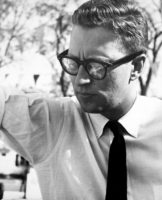Swiss architect Luigi Snozzi died Tuesday morning in a nursing home in Minusio, Switzerland. The cause of death was Covid-19. He was 88 years old.
Known for his characteristic use of exposed concrete, his urban interventions, and his theoretical approach to architecture, Snozzi was considered a leader of the Ticinese school. This group of architects included Livio Vacchini, Bruno Reichlin, Fabio Reinhart, and Mario Botta—who called Snozzi “a travel companion in the adventure of architecture”—in the Ticino region of Switzerland. From the 1960s, the group promoted rational architecture, and was linked to Aldo Rossi and the Tendenza movement in Italy. In his monograph of Vacchini, Roberto Masiero said Snozzi, more than any other architect, contributed to the creation of the particular cultural climate that promoted these talented designers and influenced architects of the region for decades to come.

For five years during the '60s Snozzi collaborated closely with the late Vacchini on numerous competitions and built works, including the very Miesian Fabrizia office building in Bellinzona (1964-65), constructed in steel, and the Snider House in Verscio (1964-65), a brick structure with a white stucco finish and flat roof, a sharp contrast to the buildings of the historical town with their steeply sloped stone slab roofing and granite masonry. Both architects were interested in a reinterpretation of the masters, but also in the ethical and political significance of the profession. In a video interview on the occasion of receiving the Swiss Grand Award for Art / Prix Meret Oppenheim in 2018, Snozzi said, “An architect above all else must have a [moral] conscience to be able to work. Without this, an architect is a disaster, a danger to the public.”
Watch a video of Snozzi from the Prix Meret Oppenheim 2018 here and below:







Post a comment to this article
Report Abusive Comment